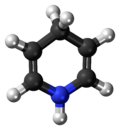1,4-Dihydropyridine
(Redirected from
Dihydropyridine
)
| |||
| Names | |||
|---|---|---|---|
| Preferred IUPAC name
1,4-Dihydropyridine[1] | |||
| Identifiers | |||
3D model (
JSmol ) |
|||
| ChemSpider | |||
| MeSH | 1,4-dihydropyridine | ||
PubChem CID
|
|||
| UNII | |||
CompTox Dashboard (EPA)
|
|||
| |||
| |||
| Properties | |||
| C 5H 7N | |||
| Molar mass | 81.1158 g mol−1 | ||
Except where otherwise noted, data are given for materials in their standard state (at 25 °C [77 °F], 100 kPa).
| |||
1,4-Dihydropyridine (DHP) is an
NADPH are derivatives of 1,4-dihydropyridine. 1,4-Dihydropyridine-based drugs are L-type calcium channel blockers, used in the treatment of hypertension. 1,2-Dihydropyridines are also known.[3][4]
Properties and reactions
A recurring feature of 1,4-dihydropyridines is the presence of substituents at the 2- and 6-positions. Dihydropyridines are enamines, which otherwise tend to tautomerize or hydrolyze.[citation needed]
The dominant reaction of dihydropyridines is their ease of oxidation. In the case of dihydropyridines with hydrogen as the substituent on nitrogen, oxidation yields pyridines:
- CH2(CH=CR)2NH → C5H3R2N + H2
The naturally-occurring dihydropyridines NADH and NADPH contain N-alkyl groups. Therefore, their oxidation does not yield pyridine, but N-alkylpyridinium cations:
- CH2(CH=CR)2NR' → C5H3R2NR' + H−
See also

- Dihydropyridine calcium channel blockers
- Hantzsch ester[5]
- Dihydropyridine receptor
References
- ^ "1,4-dihydropyridine - Compound Summary". Pubchem Compound. US: National Center for Biotechnology Information. 27 March 2005. Identification and Related Records. Retrieved 1 November 2011.
- doi:10.3987/REV-87-370 (inactive 2024-03-07).)
{{cite journal}}: CS1 maint: DOI inactive as of March 2024 (link - .
- doi:10.1039/B101371H.
- .
External links
- Dihydropyridines at the U.S. National Library of Medicine Medical Subject Headings (MeSH)


